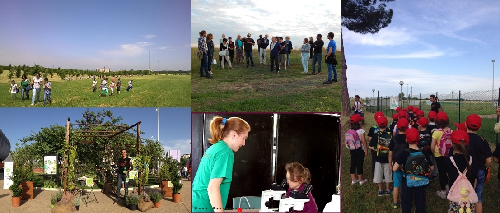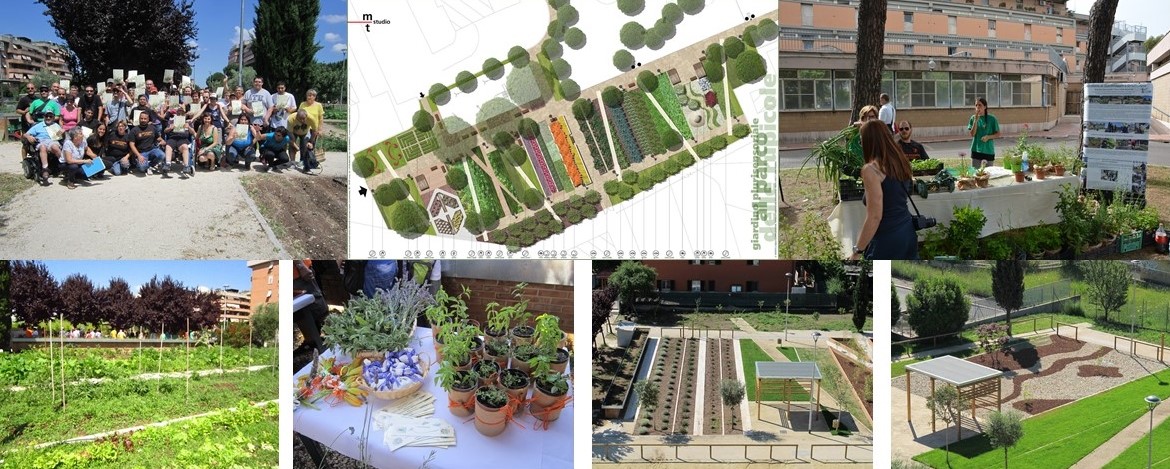Purpose and Philosophy
The Botanic Garden of the University of Rome Tor Vergata
The Botanic Garden of the University of Rome Tor Vergata aims at creating an area available to everyone, combining outdoor activities with education, culture and science. Such new concept of Botanic Garden shall combine different aspects, e.g. education, research, biotechnology, soil bioengineering, innovation and industrial development.
In order to achieve its goals the Botanic Garden is presented as:
Scientific Institution
The Botanic Garden aims at being a research platform for taxonomy, morphology, plant physiology, genetics, ecology, biotechnology, sports medicine, environmental engineering etc. run by the Garden staff in collaboration with the Faculty and Researchers of the Department of Biology of the University of Rome Tor Vergata - to which the Botanic Garden belongs - and all other university departments.
Current research fields include:
- Phytoremediation: use of plant species for polluted soil and water remediation; search for new cultivars which can have better restructuring capacity combined with biomass production.
- Alternative Energy Sources: Search for plant species with high biomass production to be used as alternative energy sources.
- High-efficiency modules for CO2 removal: Study of CO2 absorption by each plant species via a next-generation meteorological unit; search for species with high CO2 absorption efficiency; design of high-efficiency modules for CO2 absorption consisting of native species for street furniture and road borders.
- Germplasm Conservation Centre: Restoration and preservation of ancient cultivars of agricultural interest; germplasm conservation of native species, be they threatened or not.
- Food certification and food quality; Qualitative and nutraceutical tests on different foodstuffs, wine, oil and on honey in particular (Honey Research Centre).
- Experimental Nursery of medicinal plants and native species.
- Research on herbaceous species to build low-maintenance turfs and lawns.
Exchange platform with businesses
The Botanic Garden shall be regarded as a research institution serving private and public sectors in its fields of competence. There are many integrated and sectoral projects carried out with private companies to search for new industrial solutions.
Cultural Institution
The Botanic Garden leads visitors on a journey through the world of plants, inviting them to explore the different garden environments. In the future, visitors will be led to find out about past and present cultures through a series of formal gardens. Moreover, the Garden staff is constantly engaged in outreach activities by organising thematic days to introduce people to the world of plants, environmental respect, ecology and plant biotechnology.
In such context, within the Botanic Garden some sports events are periodically held (Picture 7): a perfect combination of sports and nature which in 2015 involved about 3,000 people thanks to associations of cycling, running, etc..
Furthermore, in 2014 a collaborative project between the Botanic Gardens and the Italian Golf Federation was launched, creating a training field within the Garden which has many purposes. Not only does the Botanic Garden offer everyone a chance to get closer to this sport in the open air, but it also carries out research on a new turf blend used on training fields which has lower demand for water and maintenance compared to traditional turf.
 7: Physical activity in the Botanic Garden.
7: Physical activity in the Botanic Garden.
The Botanic Garden is a unique field of study with numerous educational activities (Picture 8). The Garden staff encourages young people, all students and the whole population to get closer to botany, natural science, green biotechnology, ecology and environmental protection. The Botanic Garden provides guided tours for all ages led by its staff and offers a variety of educational workshops for schools. In 2015 about 2,000 people have visited and taken part in Garden activities.

8: Educational Activities.
Social Institution
The Botanic Garden is an integral part of Tor Vergata urban fabric. It serves as environmental conscience of the City, promotes policies about tree planting, environmental conservation and environmental public awareness. Over the years, it has established a special relationship with local residents and has offered high-level skills in support of community development and management of green areas. Hence, a number of collaborations with the local health service (ASL) and social cooperatives have been started in order to develop hortotherapy and social inclusion projects.
In this context the Botanic Garden manages the Rupicolous Park (Picture 9), a green area located in the east of Rome (VI Municipality) with a sensory garden. This garden aims to create a space for all neighbourhood residents where recreational, socialisation, employment and rehabilitation activities can be performed.
In the garden numerous projects involving children with physical/mental disabilities are carried out (Società Cooperativa Sociale COSPEXA and Mental Health Centre patients). These projects include cultivating small social vegetable gardens with therapeutic/rehabilitating goals.
The ‘sensory garden’ occupies an area of approximately 4,000 square metres in the Rupicolous Park and is articulated as follows: 4 main areas, i.e. the Italian Renaissance garden, the Arabian garden, the Japanese garden and the bamboo garden; there are also 3 sensory installations, i.e. the garden of taste, the garden of smell and the pomarium sundial; a recreational tactile path is available too.

9: Rupicolous Park.

